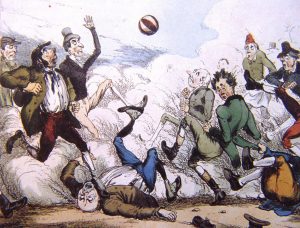
Evidence of organised football games in Greece and China goes back more than 2,000 years, but historians have no idea how these games were played. Claims that football of some sort was played throughout the Roman Empire are plausible, but the game of harpastum, often cited in support of these claims, seems to have involved throwing a ball rather than kicking it. Although kicking games were played by the indigenous peoples of North America, they were much less popular than the stickball games that are the origin of the modern game of lacrosse.

The folk football games of the 14th and 15th centuries, which were usually played at Shrovetide or Easter, may have had their origins in pagan fertility rites celebrating the return of spring. They were tumultuous affairs. When village competed against village, kicking, throwing, and carrying a wooden or leather ball (or inflated animal bladder) across fields and over streams, through narrow gateways and narrower streets, everyone was involved—men and women, adults and children, rich and poor, laity and clergy. The chaotic contest ended when some particularly robust or skilful villager managed to send the ball through the portal of the opposing village’s parish church. When folk football was confined within a single village, the sides were typically formed of the married versus the unmarried, a division which suggests the game’s origins in fertility ritual.
The game was violent. The French version, known as soule, was described by Michel Bouet in Signification du sport (1968) as “a veritable combat for possession of the ball,” in which the participants struggled “like dogs fighting over a bone.” The British version, which has been researched more thoroughly than any other, was, according to Barbarians, Gentlemen and Players (1979) by Eric Dunning and Kenneth Sheard, “a pleasurable form…of excitement akin to that aroused in battle.”
Not surprisingly, most of the information about medieval folk football is derived from legal documents. Edward II banned the game in 1314, and his royal successors repeated the prohibition in 1349, 1389, 1401, and 1423, all in a vain attempt to deprive their disobedient subjects of their disorderly pleasure. Despite the bans, records of criminal trials continue to refer to lives lost and property destroyed in the course of an annual football game. The most detailed account, however, is Richard Carew’s description of “hurling to goales,” from his Survey of Cornwall (1602).
That British folk football did not become appreciably more civilized with the arrival of the Renaissance is suggested by Sir Thomas Elyot’s condemnation in The Governour (1537). He lamented the games “beastely fury, and extreme violence.” Even James I, who defended the legitimacy of traditional English pastimes when they were condemned by the Puritans, sought to discourage his subjects from indulging in folk football. He wrote in Basilikon Doron; or, His Majesties Instructions to His Dearest Sonne, Henry the Prince (1603) that the “rough and violent” game was “meeter for mameing than making able the [players] thereof.”

In Renaissance Italy the rough-and-tumble sport of folk football became calcio, a game popular among fashionable young aristocrats, who transformed it into a highly formalized and considerably less violent pastime played on bounded rectangular spaces laid out in urban squares such as Florence’s Piazza di Santa Croce. In his Discorso sopra il gioco del calcio fiorentino (1580; “Discourse on the Florentine Game of Calcio”), Giovanni Bardi wrote that the players should be “gentlemen, from eighteen years of age to forty-five, beautiful and vigorous, of gallant bearing and of good report.” They were expected to wear “goodly raiment.” In a contemporary print, uniformed pikemen guard the field and preserve decorum. (In 1909, in a moment of nationalistic fervour, the Federazione Italiana del Football changed its name to the Federazione Italiana Gioco del Calcio.)
As an aspect of more or less unbroken local tradition, in towns such as Boulogne-la-Grasse and Ashbourne (Derbyshire), versions of folk football survived in France and Britain until the early 20th century. Although all modern football sports evolved from medieval folk football, they derive more directly from games played in schoolyards rather than village greens or open fields. In 1747, in his “Ode on a Distant Prospect of Eton College,” Thomas Gray referred to the “flying ball” and the “fearful joy” that it provided the “idle progeny” of England’s elite. In the late 18th and early 19th centuries at Eton, Harrow, Shrewsbury, Winchester, and other public schools, football was played in forms nearly as violent as the medieval version of the game. When the privileged graduates of these schools went on to Oxford and Cambridge, they were reluctant to abandon their “fearful joy.” Since none of them were ready to play by the rules of someone else’s school, the only rational solution was to create new games that incorporated the rules of several schools.

The institutional basis for the most widely played of these new games was England’s Football Association (1863). References to “Association football” were soon abbreviated to “soccer.” Graduates of Rugby School, accustomed to rules that permitted carrying and throwing as well as kicking the ball, played their game, rugby, under the aegis of the Rugby Football Union (1871). When Thomas Wentworth Wills (1835–80) combined Rugby’s rules with those from Harrow and Winchester, Australian rules football was born. In the United States, rugby was quickly transformed into gridiron football. (The name came from the white stripes that crossed the field at 10-yard [9.1-metre] intervals.) Although Gaelic football is similar to these other “codes,” that game was institutionalized under the auspices of the Gaelic Athletic Association (1884) as a distinctively Irish alternative to the imported English games of soccer and rugby.
Source: From Football article on Britannica.com by Allen Guttmann, Professor of English and American Studies, Amherst College, Massachusetts.